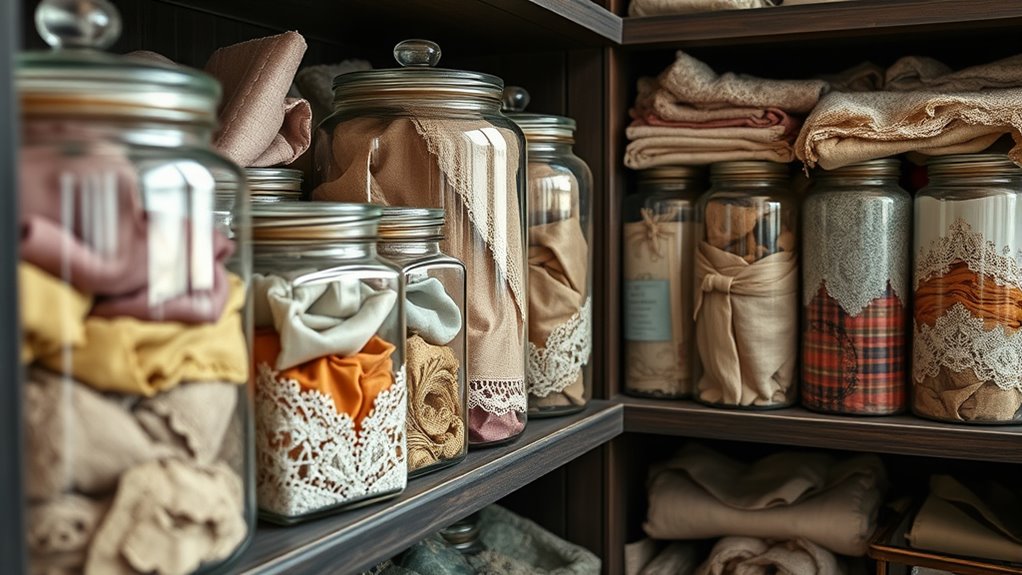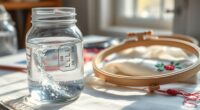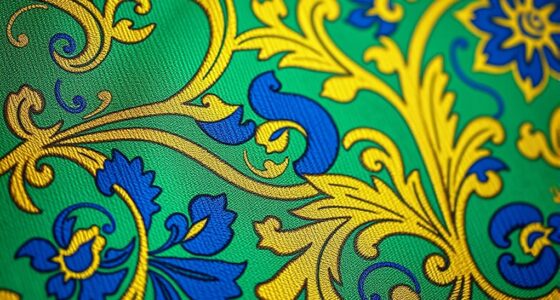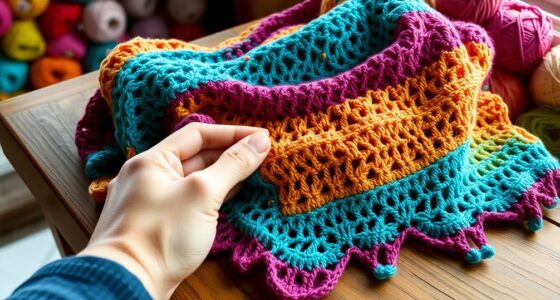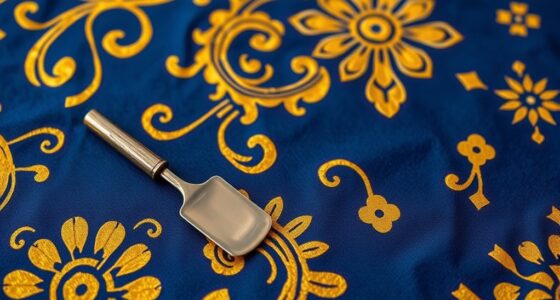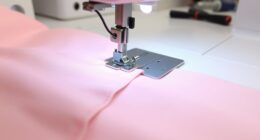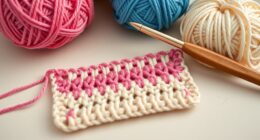To prevent yellowing and mold in your vintage fabrics, guarantee they are thoroughly cleaned and completely dry before storage. Store them in cool, dark, and stable environments away from sunlight, heat, and humidity fluctuations. Use breathable materials like cotton or linen bags and wrap fabrics in acid-free tissue paper. Keep an eye on your textiles with regular inspections to catch any issues early. If you want tips on maintaining their beauty, there’s more to discover.
Key Takeaways
- Store fabrics in a cool, dry, and dark environment to prevent exposure to light and humidity that cause yellowing and mold.
- Clean fabrics thoroughly before storage and ensure they are fully dry to inhibit mold growth.
- Use acid-free tissue paper and breathable containers like cotton or linen bags to buffer environmental pollutants.
- Roll small fabric pieces around acid-free tubes and store flat to minimize creases and fiber stress.
- Regularly inspect stored textiles for signs of deterioration, cleaning mold promptly and ensuring complete drying.
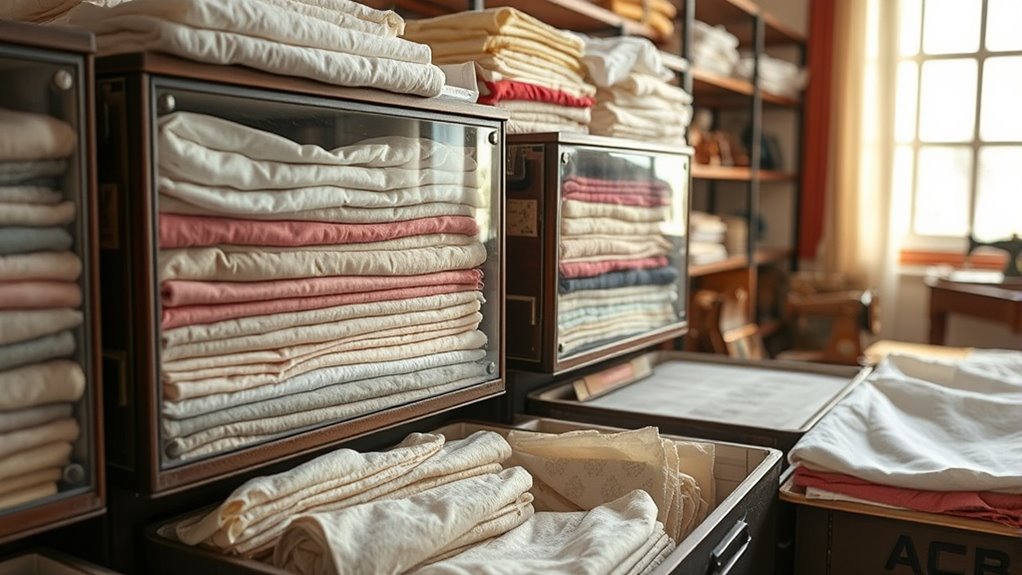
Storing vintage fabrics properly is essential to preserving their beauty and longevity. When you handle these delicate textiles, understanding the importance of correct fabric care and preservation techniques can make all the difference. Vintage fabrics are often fragile and susceptible to environmental damage, such as yellowing and mold growth, which can compromise their integrity and aesthetic appeal. By paying close attention to how you store these pieces, you guarantee they remain in excellent condition for years to come.
First, always guarantee your fabrics are thoroughly clean before storage. Dirt, oils, and residues can accelerate deterioration, so gently clean your vintage fabrics using appropriate methods—either dry cleaning or very mild hand washing—depending on the fabric type. Once clean, let them fully dry to prevent moisture from becoming trapped during storage. Moisture is a primary factor in mold development, so keeping fabrics dry is vital. To further protect your textiles, consider wrapping them in acid-free tissue paper, which helps buffer against environmental pollutants and minimizes chemical reactions that cause yellowing over time.
Choosing the right storage environment is equally important. Keep your vintage fabrics in a cool, dry space away from direct sunlight, which can cause rapid fading and yellowing. Fluctuations in temperature and humidity promote mold growth and fabric degradation, so aim for a stable climate—ideally around 65-70°F with 50% relative humidity. Avoid basements or attics, as these areas tend to have more extreme conditions. If possible, store fabrics flat, especially if they’re large or delicate, to prevent creases and stress on fibers. Rolling smaller pieces around acid-free tubes can also be effective, minimizing fold lines that can weaken fabric fibers over time.
Proper preservation techniques extend beyond just environment and cleaning. Use breathable storage containers, such as cotton or linen bags, rather than plastic, which can trap moisture and promote mold growth. Check your stored fabrics periodically for signs of deterioration, yellowing, or mold, and address any issues immediately to prevent further damage. If you notice any mold, isolate the affected fabric and gently clean it using appropriate mold removal methods, ensuring it’s thoroughly dried afterward. Additionally, understanding fabric deterioration causes can help you implement better preservation strategies and extend the life of your vintage textiles.
Frequently Asked Questions
Can Specific Fabric Types Require Unique Storage Methods?
You might wonder if different fabric types need special storage methods. Yes, some fabrics, like silk or wool, require specific fabric treatment to prevent damage, discoloration, or mold. Choosing the right storage containers is vital—use acid-free boxes or breathable covers to protect delicate materials. Always research each fabric’s needs, and tailor your storage approach to guarantee your vintage textiles stay pristine and free from yellowing or mold over time.
How Often Should Vintage Fabrics Be Inspected During Storage?
Think of fabric inspection as tending a delicate garden—you need regular attention to keep it thriving. You should inspect your vintage fabrics at least every 3 to 6 months during storage. This Storage frequency guarantees you catch signs of yellowing, mold, or pests early. Regular fabric inspection helps maintain their condition and preserves their beauty for years to come, so your treasures stay as timeless as ever.
Are There Natural Remedies to Remove Existing Yellowing?
If you’re looking for natural cleaning options to remove yellowing, try gentle remedies like soaking fabrics in a mixture of hydrogen peroxide and water or using lemon juice and sunlight for bleaching. These yellowing remedies can be effective without harsh chemicals. Just test on a small area first, and avoid overexposure to prevent damage. Regularly inspecting your vintage fabrics helps maintain their condition and keeps yellowing at bay.
What Are the Best Environments for Long-Term Storage?
You should store your vintage fabrics in a cool, dark, and dry environment. Keep humidity control low to prevent mold growth and avoid excessive light exposure, which can cause yellowing over time. Use breathable storage containers like cotton or muslin to allow air circulation. By maintaining stable temperature and humidity, and limiting light, you protect your fabrics for long-term preservation and preserve their beauty.
How Do I Safely Handle Fragile Vintage Fabrics?
Imagine holding a delicate vintage fabric, its history whispering through every fiber. To handle it safely, always check fabric pH levels to avoid damage. Use gentle handling techniques—wear clean gloves, support the fabric fully, and avoid stretching or pulling. This careful approach preserves its integrity and beauty. By respecting its fragility, you ensure your vintage treasure remains stunning and timeless for generations to come.
Conclusion
To keep your vintage fabrics pristine, you must store them carefully, protect them from moisture, and keep them out of direct sunlight. By doing so, you preserve their beauty, prevent yellowing, and ward off mold. Think of your fabrics as treasures to be cherished, their colors and textures shining brightly, their history intact. With proper care, your vintage fabrics will remain timeless, beautiful, and ready to tell their story for generations to come.
